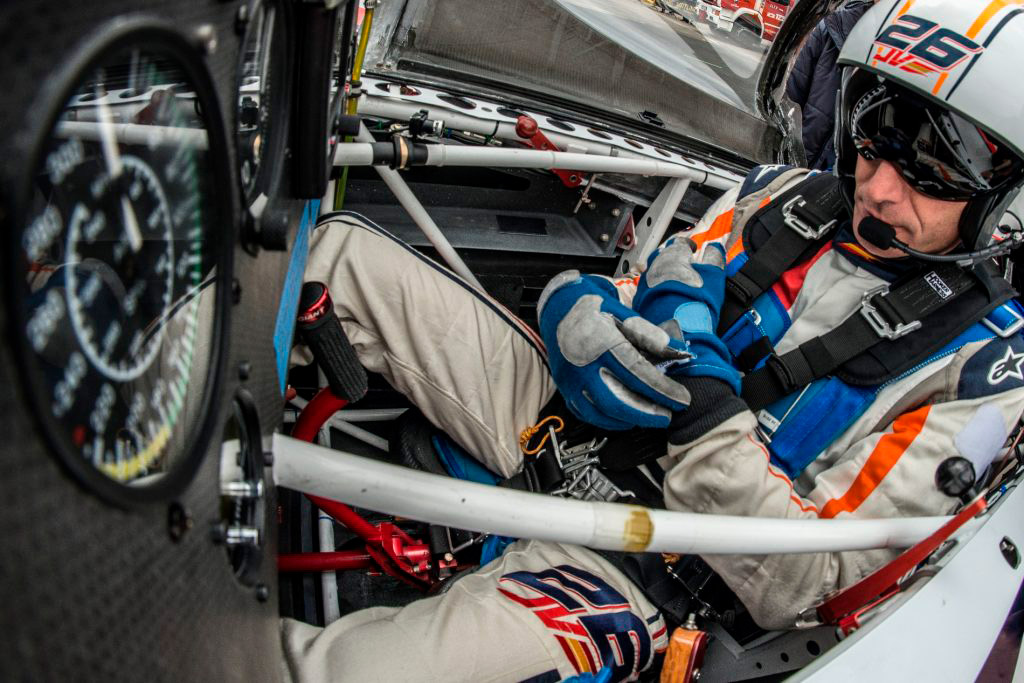Hello again, Box Repsol friends! I’m writing this with my bags packed ready to go to Kazan, where I’ll once again be competing next weekend. I’d like to tell you about my personal training, how we prepare the plane, and how the team prepares everything to achieve our goal.
First, the planes we use are exclusively for competition. They have a good deal of power, reaching speeds of up to 450 km/h with a very good thrust to weight ratio. They maintain much of their power in tight turns, which is very useful for high-speed manoeuvres. They are made almost entirely of carbon fibre with a tube frame and are very strong machines that are capable of withstanding high g-forces. They are also very agile with high manoeuvrability, allowing them to rotate 420° in one second. That’s almost one and a half turns in less than a second!
With a plane like that, you can do almost anything. But to pilot it and be able to withstand the g-force we experience, us pilots need to undergo very important physical training. It is crucial that we strengthen our torso and especially our abdomen. We also must have good cardiovascular fitness. That’s why I follow an aerobic exercise plan with a personal trainer.
Boxing is also part of my training. I’m just an amateur, because if I were to do it professionally…I’m sure I would end up injured, ha ha ha! Boxing gives you a lot of stamina. It also requires technique and reflexes that help to tone your muscles significantly. All of this is very important for high-speed flight and that’s why this part of my training helps me when I compete.

As pilots, we are the face of competitive aerobatics, but having a good team is also essential. Four people travel to the races including a pilot, a team coordinator who handles logistics, a tactical specialist who handles the telemetry, and a mechanic who assembles the plane and fine tunes it. In addition to this team, in Spain we have three more engineers who we work with to improve the aircraft’s technology and create flight simulators. Without a good team you’ve got no chance of winning, even if you have a good plane and you’re a good pilot. It’s a group effort.
When I started out in the sport many years ago, what I was looking for was something different from my experience as an airline pilot. I wanted to do different things, fly planes upside-down, leave behind the normal ways of flying. Now that I’m in the world of competition aerobatics, I realise that it is very different from my experience with commercial flights, although both provide very interesting things professionally.
In a commercial airliner, state-of-the-art technology is used, along with the highest safety requirements. Just flying such a large machine is gratifying, but on the other hand, competition aerobatics gives you a lot of intense sensations. On the track, we fly without looking at the instruments. All the aerodynamic and physical laws are limited to your own senses, and that is pretty amazing.

To finish, I’d like to tell you something that I’m often asked — why do I have number 26 on my plane? It’s not just a coincidence, but actually a lot of them! For a long time in my competitive career, I flew a Sukhoi Su-26. When we started working with the Repsol sponsorship, Marc Márquez visited us at the aerodrome to get to know us. He was the one who christened our planes, Cástor Fantoba’s with his number 93 and mine with Dani Pedrosa’s 26. Interestingly, in my first season in the Red Bull Air Race, the factory number of the plane I flew—an Edge 540—was number 26. So when they asked me what number I wanted to compete with, I knew exactly what I wanted.
Thanks to all our Box Repsol fans for your support. We hope to have some good times from here until the end of the season.
Juan Velarde.
Repsol Pilot in the Red Bull Air Race


 Join Us
Join Us  Join Us
Join Us 